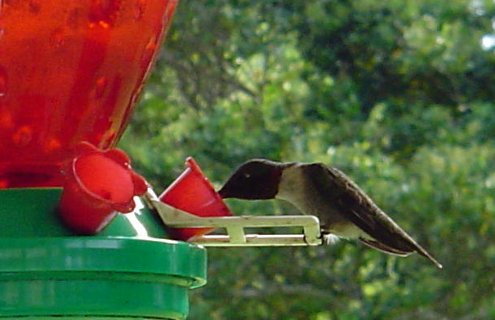
This picture pulled from my old archives is a female Ruby-Throated Hummingbird. She and her man were the first hummingbirds I ever had at this house. I named the pair Fred and Ginger!
Spring has offically sprung and in my neck of the woods it means it’s time to feed the hummingbirds!
Hummingbirds arrive in South Carolina sometime in late March or early April. They come after wintering in Mexico, Central America and the Caribbean Islands. It takes 18 to 20 hours for them to cross the Gulf Of Mexico, which must burn up an awful lot of fuel. And so, I like to have my feeders ready for when they arrive.
Let me tell you some interesting tidbits about these tiniest of birds!
There are about 17 species of hummingbirds in North America. Ruby-Throated Hummingbirds nest east of the Mississippi and are the most common in our area.
They flap their wings 55 times per second. That wing beat is what produces their “hum.” Their normal flight speed is about 25 miles per hour. They fly upright and not flat like most birds.
After feeding, they pull away from flowers by flying backwards, the only birds capable of this maneuver.
They are the smallest bird, but have the largest brains relative to their size. Their hearts are the largest, too, comparatively speaking. They live about four years on average, although a few have been documented to live to 12 years.
Hummingbirds don’t live in houses. Their nests are the size of walnuts and their eggs are the size of peas. Typically, a hummer lays two eggs.
Hummingbirds are smart. They know when to come in the spring and leave in the fall. That myth about leaving a hummingbird feeder out too late in the fall, causing the birds to stay and then, die from the cold, is false. They migrate due to the changing length of daylight, not whether or not you provide them with food. Although, I like to keep food available right up until the time they leave for their winter homes. After all, it’s a long trip!
And, speaking of their trip, I read another myth that hummers migrate on the backs of geese. Well, that would be something to see. But, really, this is a pretty silly idea and not true.
While it is true that hummingbirds don’t walk like other birds, they can perch and do so as often as possible. About 80% of their time is spent perching.
Hummingbirds feed on insects and nectar. Feeders are easy to maintain and provide these little creatures with an additional food source. If you don’t have a feeder, consider getting one. Make sure it has perches so the birds can take a little rest while dining.
I have two feeders. I keep one near our back deck and one on the other side of the house near our screened porch: both strategically located for my enjoyment!
You can buy nectar, although, I think that is a waste of money. It is so easy to make your own. Mix 1 part granulated sugar to 4 parts water. I make two cups of nectar at a time (one cup for each feeder). I use a glass Pyrex cup to mix the solution and then microwave it to get it hot enough to dissolve the sugar. After it cools, fill your feeder. (Do not add food coloring.)
Then, sit back and enjoy the show!


I really enjoyed reading about these lovely little creatures. It was a sweet and informative narrative on their habits. Of course, my expectations weren’t too high when I read “Zoom, zoom, zoom” – I thought you bought a Mazda.
Daneen, Ha, ha, ha! Maybe that’s the trick – create a low expectation title, so the story can only be an improvement!
I would like to travel on the backs of geese. Perhaps I can strap them to my feet like rollerskates. HONK! (that was supposed to be a goose impression).
Carrie, I’d rather have a Nimbus 2000!
I’d rather have a great big diamond! No, actually I’d like to have a new roof, new kitchen and new electric! Oh my!